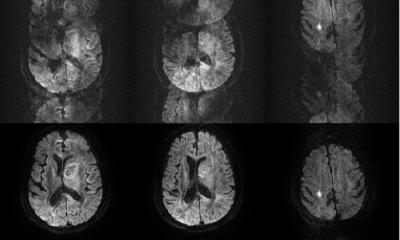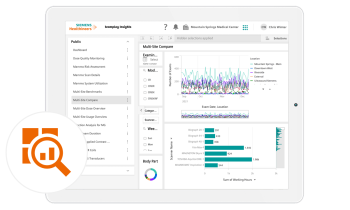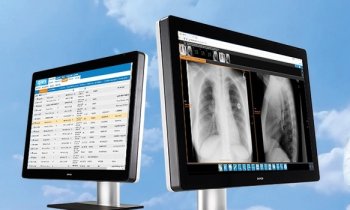Article • Security
We need to go into clouds
Cloud computing offers various benefits but also entails some risks. Nevertheless hospitals need to adopt new ways to simplify work processes and enhance care.
Report: Marcel Rasch
‘We want to improve patient care and we have the tools but, at the moment, we are using unsafe methods for image transfers,’ according to Dr. Erik Ranschaert, radiology consultant at the Jeroen Bosch Hospital in Hertogenbosch, and Chief Medical Officer for the Diagnose.me project.
The first and most convincing argument for hospitals to adopt cloud computing is economic. ‘At present hospital IT infrastructure costs are high,’ says Ranschaert, ‘but cloud computing offers the chance to change a hospital’s IT strategy. It can turn IT capital expenditure into operating expenditure.’
Currently expenditures include hardware, training, software, necessary upgrades, IT staff, etc. Such costs are increasing, especially due to growing data volumes and storage capacity. Cloud computing allows hospitals to outsource IT, significantly reducing costs. ‘Of course hospitals will need to keep some local IT and IT staff to maintain the local hard- and software,’ he agrees, ‘but the main infrastructure as well as software can be located elsewhere.’ Outsourcing will give hospitals more flexibility because different payment models, depending on the hospital’s need, are conceivable: per usage, per minute, hour or per software, etc.
Three cloud services formats
Software-as-a-service (SaaS) provides specific software applications in a cloud, Platform-as-a-service (PaaS) offers a suite of virtual applications, programming languages and tools for the user and Infrastructure-as-a-service (IaaS) relies on remote data storage networks. ‘Hospitals won’t have to install software on their own devices anymore so won’t need upgrades,’ Ranschaert adds. A big benefit would be to use and share images faster – even on mobile devices. Image post-processing can be done from a distance, on any workstation or even tablet computer. ‘Sharing information between different PACS and HIS, or with other specialists worldwide would become easier. Sharing electronic health records (EHRs) would be ideal.’
The European problem

The Mayo Clinic decided to outsource IT in 2015, selling its entire local IT department to Epic, a major US player in electronic health records and software. ‘This is a first move and very significant change,’ Ranschaert says. ‘There certainly will be hospitals that follow in the near future.’
Whereas in the USA the implementation of public cloud computing models and virtual private cloud models is becoming popular, most European networks between hospitals or in countries (e.g. NIMIS in Ireland) are based on private networks. These rely on the XDS-I model (private cloud systems), but don’t include all functions and flexibility of a full cloud-based model. There are also unanswered questions regarding data security and associated regulations. ‘Politics are too slow,’ he believes. ‘We do have regulations in Europe, but they must be adapted and changed. The directive 95/46/EU is from 1995 and the new version was accepted in 2015, but the regulation still has to be voted on by the European Parliament in plenary during spring 2016.’
Ranschaert is convinced cloud computing will triumph in Europe: ‘It provides so many benefits. Data security is a question of the cloud computing format you use.’ Cloud services can be public as well as private or hybrid solutions.’ He repeats that with cloud the hardware and software is external to a hospital – no problem if working with a private cloud vendor in the same country. However, a public cloud system, especially with providers such as Amazon, questions where the data are located and stored. Due to the new EU regulation, it’s important to define conditions on what security and privacy measures such services should have approved. Ranschaert: ‘In the US, the Image Sharing Network from the RSNA provides a key to a patient’s EHR, combined with an individual password. The patient can give this key to any specialist or hospital if needed. But legislation in the US differs from legislation in Europe.’
Illegal methods

‘The current situation is unsatisfactory. Most hospitals rely on CDs and DVDs they give to patients. Integrating these into other hospitals’ systems is sometimes a problem because of different formats. All this takes time and is very costly. In our hospital,’ he adds, ‘it’s a full-time job just to burn CDs and DVDs with patients’ data.’
‘We are forced to work in a very old-fashioned way; many practitioners go the illegal way and share their images via WhatsApp. They take a picture of the images, or of their screen, and send them to another specialist for a second opinion,’ Ranschaert explains. ‘WhatsApp is being used because it benefits a patient that images are transferred quickly for discussion; but we’re using unsafe methods, not protecting a patient’s privacy and not following privacy legislation.’
Erik Ranschaert’s Netherlands survey* two years ago showed that radiologists need to share images digitally; 93% of respondents wished to transfer digital images to other hospitals. ‘This was two years ago. In the meantime technology has developed and doctors still can’t do it. We must raise awareness that WhatsApp is very unsafe. Several Dutch studies have shown that WhatsApp is used by 40-44% of hospital physicians. They are unaware of risks and often do not remove the patients’ identifiable information on pictures sent. They want to help patients quicker and more efficiently. Meanwhile more solutions, in form of diverse platforms, are launched, but they are not structured and not efficient enough.’
Link to the survey: http://dx.doi.org/10.1594/ecr2014/C-0684
Profile:
Erik Ranschaert is a Radiology Consultant at the Jeroen Bosch Ziekenhuis in Hertogenbosch, The Netherlands, and Chief Medical Officer of the Diagnose.me project. He is currently writing his PhD thesis in medical sciences at the University of Antwerp. He is also an active member in the European Society of Radiology (ESR) eHealth and Informatics Subcommittee and a Board member of the European Society for Medical Imaging Informatics (EuSoMII).
25.02.2016











